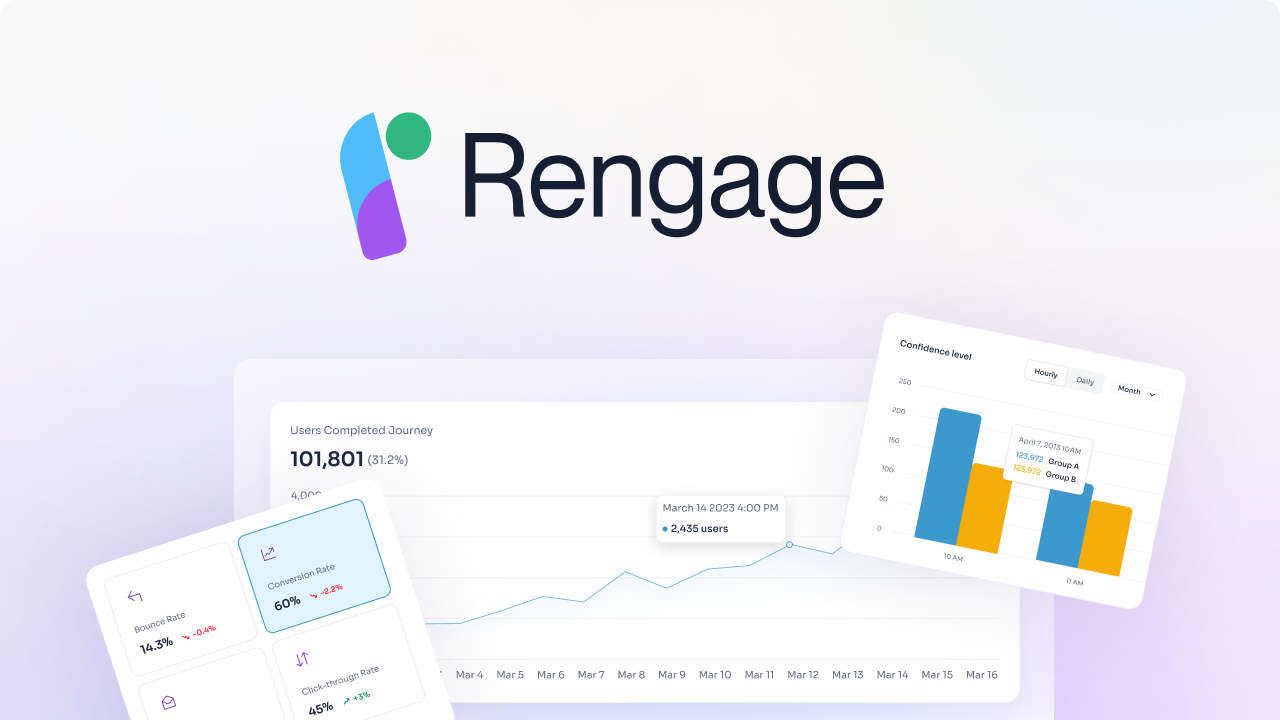SaaS Customer Journey Essentials & 7 Tools for a Seamless Experience
The right strategies, tools, and best practices can significantly enhance your customer lifecycle management processes and positively impact your business. Learn more about customer lifecycle management and SaaS customer journeys in this blog post.
What Is the SaaS Customer Journey?

The simple definition? A SaaS customer journey is the path a certain customer segment takes from the initial discovery of your product to becoming a loyal, paying, and (ideally) promoting user.
For a more fleshed-out answer, a SaaS customer journey is made up of stages and touchpoints:
Stages
Steps in your customer journey defined by what a customer needs to accomplish to move forward. For example, to move past the initial awareness stage, customers need to become aware of your product (obviously).
Touchpoints
Points of contact between you and your customers. For example, a blog post (like this one!) might be the touchpoint that moves a customer past the awareness stage.
By mapping out these stages and touchpoints, the goal is to create a more streamlined journey that gets as many customers as possible from A to B.
6 Benefits of SaaS Customer Journey Mapping

1. Empathy and Retention
Customer journey mapping gives your business and team an empathetic perspective, which focuses on the needs of customers, ultimately leading to higher retention rates.
2. Understanding Customer Wants
The SaaS customer journey map system provides a unified view of customer wants and needs across all platforms, leading to quicker response times and improved customer satisfaction.
3. Identifying Gaps
Mapping the customer journey helps in identifying gaps in the customer experience. For instance, realizing the need for a chatbot on a website can lead to new opportunities and enhance customer success.
4. Enhanced Customer Experience
Customer journey mapping helps in improving customer experience and satisfaction, leading to customer loyalty and growth.
5. Predicting Customer Behavior
Journey mapping provides insights into customer behavior, needs, and potential problems. This data helps in making informed decisions, addressing customer issues, and predicting future problems, resulting in positive business outcomes.
6. Optimized Marketing Strategies
Mapping the customer journey translates into better marketing strategies, improved customer experiences, and increased sales, leading to overall business success.
Maximizing Customer Journey Management with Rengage
We provide a comprehensive solution for managing and enhancing customer journeys, delivering insights and measurable outcomes with no code. We accelerate your customer journey from onboarding, activation to conversion and churn. Enabling customers to unlock revenue from their existing user.
With Rengage, you can get insights into your segments, run campaigns with an intuitive journey manager, and get insights to measure how your journeys impact users conversion through our Journey Moments and Journey Builder features. Journey Moments: insights into your micro-segments, Journey Builder: intuitive multi-channel marketing automation, Insights prediction and attribution.
Book a free demo to learn about how you can transform customer interactions into personalized experiences that drive loyalty and growth.
Related Reading
5 SaaS Customer Journey Stages

1. Awareness
Awareness is the easiest stage to understand. Before the awareness stage, the customer has no idea you exist; after the awareness stage, they do—simple! There are two main routes into the awareness stage:
Intentional Discovery
The customer has a problem and actively seeks a solution.
Unintentional Discovery
The customer is exposed to your product by “accident”— maybe they saw an ad or a friend mentioned it.
Regardless of how the customer entered the awareness stage, your goal is to grab their attention and introduce them to what you’re offering. That means demonstrating your product’s value as a solution to the customer’s problem.
Common SaaS Awareness Touchpoints
- Word-of-Mouth
- Social Media
- Ads (Google Ads, Paid Social)
- Content Marketing (Blogs, Videos, etc.)
2. Consideration
Customers are now aware of your product’s existence but aren’t quite sure whether it’s the right fit for them. This stage varies based on product and industry, but it’ll usually be defined by:
Learning
Customers will probably try to understand the problem your product solves.
Exploration
Customers will usually take a closer look at your product’s features and benefits.
Comparison
Customers will compare your product with other alternatives on the market.
Testing
Customers will usually want some kind of trial or demo before diving in head-first. Making sure you have resources, processes, and people in place for each of these needs (but especially testing) is key.
Common SaaS Consideration Touchpoints
- Webinars
- Product Demos
- Free Trials
- Case Studies
- Questions & Answers (Q&As)
- Sales Staff
3. Purchase (Decision)
At this stage, customers have decided to purchase your product—nice! Your goal in the purchase stage is to make sure they don’t start doubting themselves during the checkout process (i.e., making it as painless as possible).
Common SaaS Purchase Touchpoints
- Checkout Pages
- Product Configuration Pages
- Payment Pages
4. Onboarding/Service
Getting the onboarding stage right is critical for SaaS companies. According to most studies, around 86% of customers would remain loyal if they received onboarding and ongoing education. The onboarding process is usually broken down into two stages:
Initial Onboarding (or Activation)
This includes the initial setup of the product.
Continued Onboarding (or Education)
This is where customers learn to use the product more deeply.
Common SaaS Onboarding Touchpoints
- Product Tours
- Live Chat
- Checklists
- Email Series
- Video Tutorials
- User Guides & Help Centers
5. Renewal (Loyalty)
Renewal is a stage that’s especially important for SaaS companies. It’s usually a side effect of the overall customer journey—meaning that if you do all the other stages right (especially onboarding), the renewal will take care of itself.
You can do a few things to help this stage along, though. One great approach is by asking for customer input through surveys and questionnaires, an important part of the customer feedback loop.
Related Reading
- Digital Customer Journey Mapping
- Customer Journey Analysis
- Ecommerce Customer Journey
- B2B Customer Journey
- Customer Journey Orchestration
- Omnichannel Customer Journey
- Marketing Automation Customer Journey
- Customer Journey Optimization
- Micro Moments Customer Journey
- Customer Journey Research
- Customer Journey Automation
- Customer Journey Insights
- Customer Journey Dashboard
- Customer Journey Personalization
- Customer Journey Metrics
- Customer Journey Best Practices
7 Steps to Create the Perfect SaaS Customer Journey

1. Have a clear purpose
When creating a SaaS customer journey map, it is crucial to identify the main objectives and goals of your mapping process. The goals might shift as your business grows and the customer journey evolves, so it’s important to revisit them periodically. Have clear primary goals for the customer journey, such as streamlining product adoption, creating a seamless onboarding process, or minimizing churn.
2. Define every buyer type
Identify different user personas that interact with your SaaS product. Ensure you have a deep understanding of each potential buyer profile before creating the customer journey map. This process will vary depending on whether you are offering B2B or B2C solutions. Define user personas for both end-users and decision-makers who may purchase the product, considering their unique characteristics and needs.
3. Establish the stages of your customer journey
Understand the key stages that customers go through when interacting with your SaaS product. Typical stages include awareness, consideration, decision, onboarding, support, retention, and advocacy. Pay special attention to the onboarding phase, as it is crucial for recurring revenue in SaaS companies.
4. Identify the customer touchpoints at each stage
Identify major points where users interact with your brand at different stages of the customer journey. These touchpoints can include social media posts, CTAs, sign-up forms, and the product itself. Monitor these interactions to pinpoint areas for improvement and enhance the overall customer experience.
5. Highlight customer milestones
Pay close attention to significant customer milestones, such as conversion events and critical moments that influence customer retention. Focus on key touchpoints like CTAs, product demos, and self-service support to prevent users from becoming frustrated and leaving the platform.
6. Make your map cyclical
Create a cyclical customer journey map that tracks the full customer cycle from purchase to renewal. Focus on post-purchase actions like continuous onboarding, renewals, and upgrades. Ensure users are aware of new features, and make it easy for them to upgrade or renew their subscription.
7. Measure the outcome of the customer journey
Regularly measure the success of your customer journey by analyzing key milestones and touchpoints. Use qualitative and quantitative metrics to evaluate the impact on customers and your business. Collect real customer feedback to understand their experiences and improve touchpoints across the journey.
By following these seven steps and continuously refining your SaaS customer journey map, you can enhance the overall user experience, drive customer retention, and increase brand advocacy.
7 Top Tools to Optimize the SaaS Customer Journey
1. Rengage

Rengage offers a comprehensive solution for managing and enhancing customer journeys, delivering insights and measurable outcomes with no code. The platform accelerates the customer journey from onboarding, activation to conversion, and churn, enabling customers to unlock revenue from their existing user base.
With Rengage, you can gain insights into your segments, run campaigns with an intuitive journey manager, and measure how your journeys impact user conversion through Journey Moments and Journey Builder features.
2. Userpilot
Userpilot is a customer success platform that goes beyond triggering in-app experiences. The tool allows you to create in-app surveys, track user behavior, and access advanced product analytics to nurture product growth effectively.
3. ChurnZero
ChurnZero is a customer success platform specifically designed for subscription-based businesses to reduce churn rate and increase customer retention. The platform provides real-time insights, proactive management tools, understanding customer usage patterns, automating tasks, and effectively engaging with customers.
4. Gainsight
Gainsight is a comprehensive customer success platform designed to help companies drive engagement, expand revenue, and foster loyalty. It integrates seamlessly with existing CRM systems, allowing companies to effectively manage customer relationships.
5. UXpressia
UXpressia is a cloud-based customer experience management platform offering accessibility and flexibility for teams to visualize, share, present, and improve their customer journeys effectively.
6. Miro
Miro has become a favorite in the SaaS industry, offering various templates from user journey maps to kanban boards. The platform focuses on product education, providing a quick and easy process for users to get started effectively.
7. FlowMapp
FlowMapp is primarily described as a UX tool that helps teams visualize various flow maps, including site maps and customer journey maps. The platform offers a variety of templates for user journey mapping, focusing on outcomes, empathy, experience, and channel conversion.
5 Key Metrics to Measure the Impact of Your SaaS Customer Success Strategy

1. Customer Lifetime Value (CLTV)
Customer Lifetime Value is a vital metric that helps businesses understand the total revenue a customer generates over their entire relationship with the company. It considers the average monthly income per customer, average customer lifespan in months, and the average cost of acquiring and serving a customer. Calculating CLTV helps a business understand whether the money spent on acquiring and retaining customers is generating a return on investment.
2. Customer Satisfaction Score (CSAT)
Customer Satisfaction Score is a simple metric that directly tells you how satisfied your customers are with your product. It is usually measured by asking customers to rate their satisfaction on a scale of 1 to 5, or 1 to 10, where higher scores indicate higher satisfaction. If you see a low score, you know you have to work on providing better customer service.
3. Net Promoter Score (NPS)
Net Promoter Score measures the overall sentiment that your user base has over your product. It is calculated by subtracting the percentage of detractors from the percentage of promoters. This score helps you understand how loyal your customers are to your product and how likely they are to recommend it to others.
4. Churn Rate
Churn rate is the rate at which customers are unsubscribing from your app. It is calculated by dividing the number of lost customers by the total number of customers acquired during the same period. A high churn rate indicates that customers are not finding value in your product or service.
5. Customer Retention Rate
Customer retention rate is the percentage of customers who continue to use your service over a specified period. It can be calculated by dividing the number of customers at the end of a period by the number of customers at the beginning of the period and multiplying by 100. A higher customer retention rate indicates that customers are satisfied and are continuing to find value in your product or service.
9 Customer Success Strategies & Best Practices to Implement in Your SaaS

1. Personalized Onboarding Process
Personalizing the onboarding process for customers is crucial in the SaaS industry. By segmenting user bases and creating customized onboarding sequences, you can significantly improve customer success and retention rates. This tailored approach ensures that users are introduced to your product or service in a way that resonates with their needs and expectations, setting the stage for a long-lasting relationship.
2. Enhanced Value with Onboarding Emails
Onboarding emails play a pivotal role in nurturing positive relationships with new customers. By structuring a sequence of emails that guide users through the functionalities of your product or service, you can successfully engage new users and help them understand the value your offering brings. These well-crafted emails can make users feel welcome and supported, thus increasing the likelihood of customer retention.
3. Progressive Disclosure in Product UX
Implementing progressive disclosure in your product's user interface can greatly benefit customer success. By strategically revealing additional features as users navigate the product, you prevent overwhelming them and ensure a smooth user experience. This approach allows users to interact with the product at their own pace, fostering a deeper understanding and appreciation of its capabilities.
4. Personalized Demos for Increased Value
Offering personalized demos to customers can significantly impact customer success. By showcasing the value of your product in a tailored manner, you can help users understand how your solution addresses their specific needs and challenges. This personalized approach not only boosts customer satisfaction but also improves retention rates by demonstrating the real-world benefits of your offering.
5. Onboarding Checklist for Progress Tracking
Introducing an onboarding checklist can streamline the customer journey and accelerate the activation process. By outlining key tasks that lead to activation and providing a visual progress bar, users can easily track their advancement through the onboarding process. This checklist serves as a centralized hub for users to follow the necessary steps and achieve success with your product.
6. Secondary Onboarding for Continued Success
Secondary onboarding is crucial for ensuring that customers continue to derive value from your product. By introducing users to additional features beyond the core functionalities, you can exceed their expectations and enhance their overall experience. This ongoing engagement with the product not only delights customers but also improves customer satisfaction and retention.
7. Customer Engagement through Gamification
Incorporating gamification elements in your product can boost customer engagement and success. By adding badges, progress bars, and other fun incentives, you create an enjoyable user experience that motivates users to explore and utilize your product more effectively. This positive reinforcement loop not only enhances user satisfaction but also increases retention rates.
8. In-App Guidance for Increased Satisfaction
Utilizing in-app guidance is an effective way to engage users and enhance their understanding of your product. By providing interactive walkthroughs and concise messages, you can educate users on key features and functionalities. This personalized approach fosters exploration and learning, ultimately improving customer satisfaction and retention rates.
9. Drive Success through Customer Education
Continuous customer education is essential for maintaining user engagement and satisfaction. By offering webinars, tutorials, and other educational content, you empower users to maximize the value they derive from your product. This ongoing engagement not only strengthens customer relationships but also drives long-term success.
Related Reading
- Customer Lifecycle Management Software
- Customer Journey Mapping Tools
- Customer Journey Management
- Braze Alternative
- Fullstory Alternatives
- Adobe Analytics Alternatives
- Customer Journey Analytics Tools
- Iterable Competitors
- Marketo Alternatives
- Onesignal Alternatives
- Clevertap Alternatives
- Bloomreach Alternatives
- Customer.io Alternatives
Create Personalized Experiences That Drive Loyalty and Growth with Rengage — Book A Free Demo Today
Rengage is a powerful solution that assists businesses in managing and improving their customer journeys. With Rengage, users can gain valuable insights and achieve measurable outcomes with no requirement for coding. Our platform is designed to expedite the customer journey from the initial onboarding stage through activation, conversion, and churn. By utilizing Rengage, businesses can unlock additional revenue from their existing user base.
Unlocking Insights and Campaign Execution
Rengage offers several key features that set it apart. Users can delve into their segments to gain valuable insights, execute campaigns through an intuitive journey manager, and measure the impact of their journeys on user conversion rates. The platform's Journey Moments feature provides insights into micro-segments, enabling businesses to understand their audience on a more granular level.
Streamlining Marketing Automation with Rengage's Journey Builder
The Journey Builder tool offers an intuitive, multi-channel marketing automation solution that streamlines the campaign execution process. Rengage also provides predictive insights and attribution data, allowing businesses to make informed decisions based on accurate information.
Driving Loyalty and Growth with Personalized Customer Experiences
Businesses seeking to enhance customer interactions and drive loyalty and growth would benefit from Rengage's transformative capabilities. By leveraging our platform, companies can create personalized experiences that resonate with their target audience, ultimately leading to increased customer loyalty and revenue growth. Book a free demo today to learn how Rengage can help you achieve your business goals.